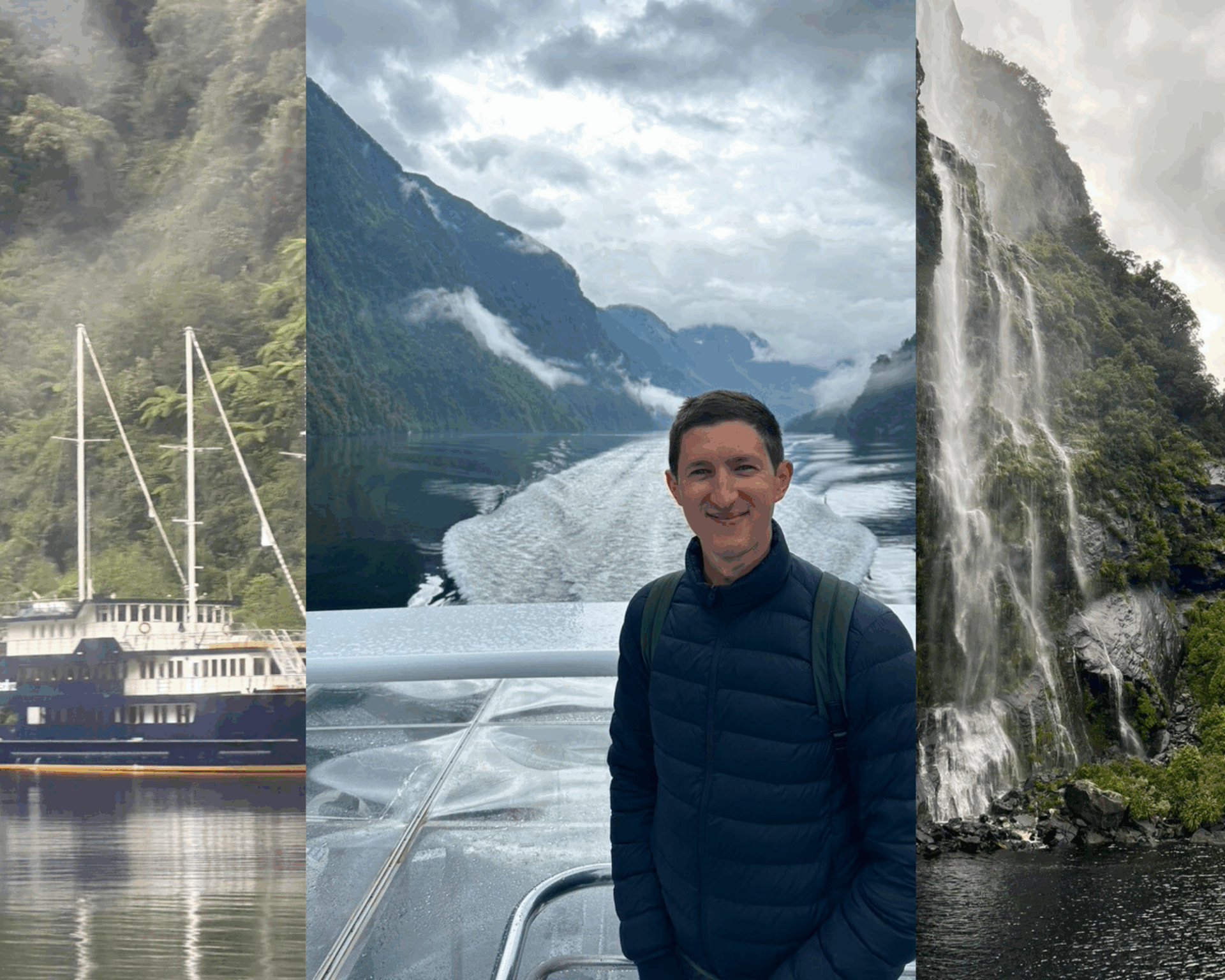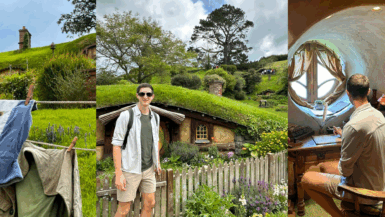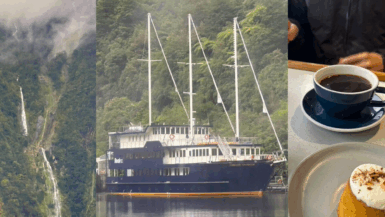Table of Contents
Quick Overview: Best Time to Visit Doubtful Sound
- Best overall months: November (Hayden’s pick), summer (Dec–Feb), and spring (Sep–Nov)
- Summer (Dec–Feb): Warmest, popular for kayaking/swimming on overnight cruises — book early
- Autumn (Mar–May): Moody skies, great for photographers, fewer crowds
- Winter (Jun–Aug): Quietest, misty landscapes, lowest prices
- Spring (Sep–Nov): Active wildlife, flowing waterfalls, fewer tourists
- Wildlife highlights: Dolphins (year-round), Penguins (spring), Seals & birdlife (best in warmer months)
- Cruises run all year: Overnight cruises limited in winter
- Tour Options & Booking Links:
- Day Trip to Doubtful Sound from Queenstown
- General Doubtful Sound Day Cruise
- Doubtful Sound Overnight Cruise
- Related Reads and Additional Resources:
- Which Doubtful Sound Cruise Experience Is Right for You?
- Milford Sound vs. Doubtful Sound
- How to Get to Doubtful Sound from Queenstown or Te Anau
Tucked deep within Fiordland National Park, Doubtful Sound is one of New Zealand’s most remote and untouched natural wonders. While it’s a year-round destination, the experience you’ll have depends heavily on when you go — from misty winter mornings with not another soul in sight to summer afternoons paddling through glassy water under the sun. So, when is the best time to visit Doubtful Sound?
In this guide, I’ll walk you through what to expect in every season — including weather patterns, wildlife sightings, cruise options, and crowd levels — to help you choose the best time of year to go. Whether you’re chasing dolphins, waterfalls, or just fewer people, this will help you plan the kind of Doubtful Sound trip that sticks with you.
This post contains affiliate links, which means I may earn a small commission if you book through them — at no extra cost to you.
Doubtful Sound Weather by Season
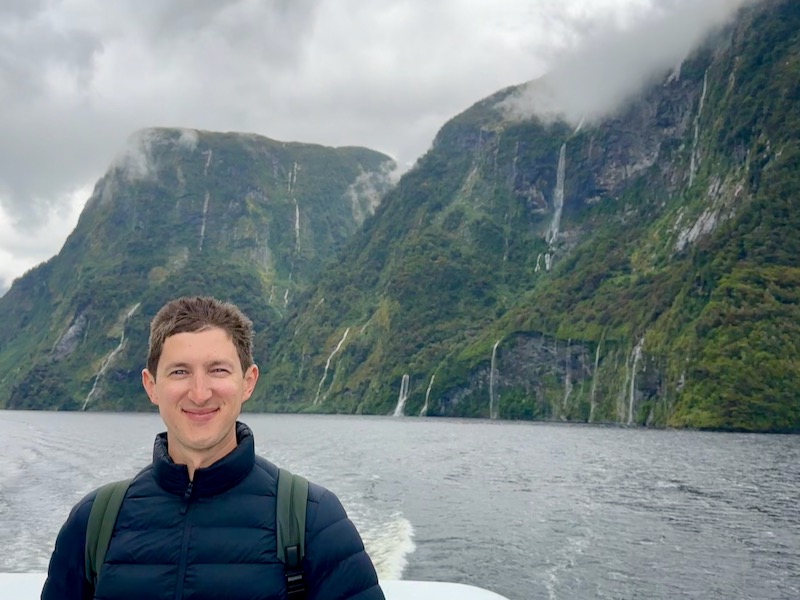
Despite its remote location, Doubtful Sound is accessible year-round — but the experience changes dramatically depending on when you go. Fiordland is known for its rainfall (it’s part of the magic), and no matter the season, you should come prepared for a mix of sun, rain, wind, and mist — sometimes all in one day. Here’s a breakdown of what to expect each season, and how weather affects your time on the water.
Spring (September–November)
This is the season I visited, and I absolutely loved it. Spring brings lush greenery, blooming flora, active wildlife, and those legendary Fiordland downpours that turn the cliffs into walls of waterfalls. Yes, it rained during most of my trip, but honestly? That’s part of what made it so incredible.
- Average temps: 6°C to 15°C (43°F to 59°F)
- Daylight: Increasing from 10 to 14 hours
- Rainfall: Frequent but photogenic — waterfalls everywhere
- Crowds: Moderate; increasing in late November
- Best for: Waterfall lovers, wildlife enthusiasts, shoulder-season explorers
Pro Tip: Don’t be scared off by rain. November was stunning — the waterfalls were next-level, and the crowds were low enough to feel the quiet.
Summer (December–February)
Summer is the most popular time to visit Doubtful Sound — and for good reason. Days are longer, temperatures are warmer, and conditions are generally more stable. It’s the ideal season for outdoor activities like kayaking, swimming (yes, people really do it!), and stargazing on overnight cruises.
- Average temps: 10°C to 20°C (50°F to 68°F)
- Daylight: Up to 15 hours
- Rainfall: Still common, but usually lighter and less frequent
- Crowds: Peak season — book cruises early, especially over the holidays
- Best for: Active travelers, warmer weather, full-day or overnight cruises
Pro Tip: If you’re keen on kayaking or swimming, summer is the time — just plan ahead, because spots book up fast.
Autumn (March–May)
Autumn brings cooler temps and a noticeable drop in visitor numbers. You’ll still get a mix of sunny and rainy days, but this shoulder season offers a moodier atmosphere — perfect for dramatic landscape photography and quieter cruises.
- Average temps: 6°C to 16°C (43°F to 61°F)
- Daylight: Decreasing from 13 to 10 hours
- Rainfall: Moderate, with misty mornings and moody skies
- Crowds: Thinning out, especially late autumn
- Best for: Photographers, couples, travelers avoiding crowds
ProTip: Autumn is underrated. If you’re after peaceful landscapes and misty vibes, this is one of the best times to go.
Winter (June–August)
The coldest and quietest time of year, winter in Doubtful Sound is raw and atmospheric. Expect moody skies, dramatic fog, and snow-dusted peaks in the distance. While not all overnight cruises run during this time, the solitude can be magical.
- Average temps: 2°C to 10°C (36°F to 50°F)
- Daylight: As little as 9 hours
- Rainfall: Frequent and heavy — but that means epic waterfalls
- Crowds: Minimal — you might feel like you have the Sound to yourself
- Best for: Budget travelers, solitude seekers, dramatic scenery lovers
Pro Tip: Don’t rule out winter — the atmosphere is surreal. Just pack warm and check cruise availability in advance.
When Is the Best Time to Cruise Doubtful Sound?
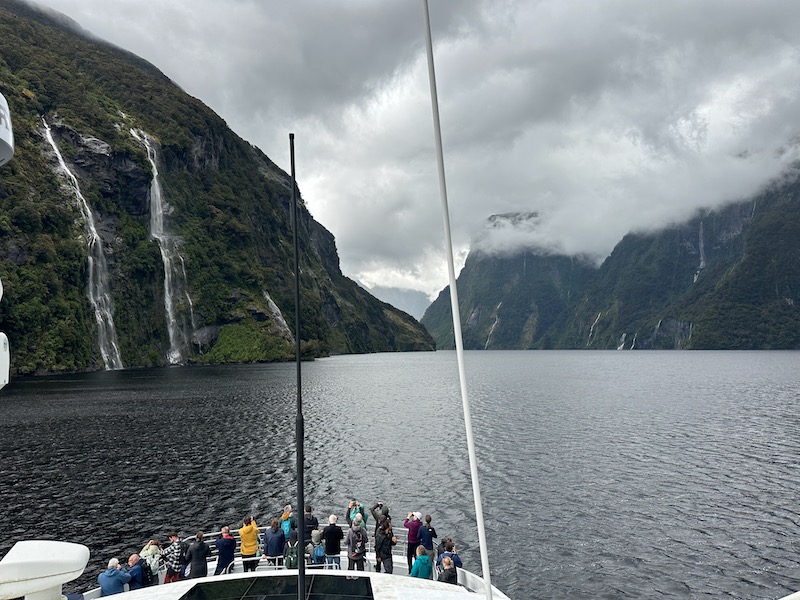
One of the best ways to experience Doubtful Sound is by boat — and luckily, cruises run all year. But the type of cruise you choose, and the time of year you go, can totally change the vibe of your trip. Here’s what to expect season by season, including the pros and cons of day vs. overnight cruises.
Cruises Run Year-Round, But Conditions Vary
You’ll find two main types of Doubtful Sound cruises:
- Day Cruises (most common, run year-round)
- Overnight Cruises (more immersive, not always available in winter)
Day cruises are generally more flexible and available year-round, even in the depths of winter. Overnight cruises, on the other hand, tend to operate more consistently from spring through autumn. Winter sailings may be limited or paused depending on the operator and weather conditions.
Best Time for a Day Cruise
If you’re short on time or based in Queenstown or Te Anau, a day cruise is your most practical option. These tours include the scenic ferry across Lake Manapouri, a coach ride over Wilmot Pass, and a few hours exploring the fiord by boat.
- Summer: Long daylight and calmer weather make this the most popular season
- Spring & Autumn: Quieter, with incredible waterfalls and changing landscapes
- Winter: Cold, but beautifully atmospheric with low crowds — a photographer’s dream
Best Time for an Overnight Cruise
Overnight cruises are more intimate and give you the rare experience of waking up in the fiord — often with nobody else around. These trips usually include meals, kayaking, and even swimming (if you’re brave enough).
- Best Months: November through March
- Kayaking & Swimming: Most enjoyable in summer when temps are higher
- Winter: Fewer departures and less favorable weather, but some companies still offer sailings
Pro Tip: If you’re planning an overnight cruise in summer, book early. These fill up fast, especially around Christmas and New Year.
Cruise Types Available by Season
| Season | Day Cruises | Overnight Cruises | Notes |
|---|---|---|---|
| Summer | Yes | Yes | Most options available; peak demand |
| Autumn | Yes | Limited | Quieter, great for moody scenery |
| Winter | Yes | Possibly limited | Stunning atmosphere, check availability |
| Spring | Yes | Yes | My personal pick — waterfalls + wildlife |
Wildlife Sightings by Season
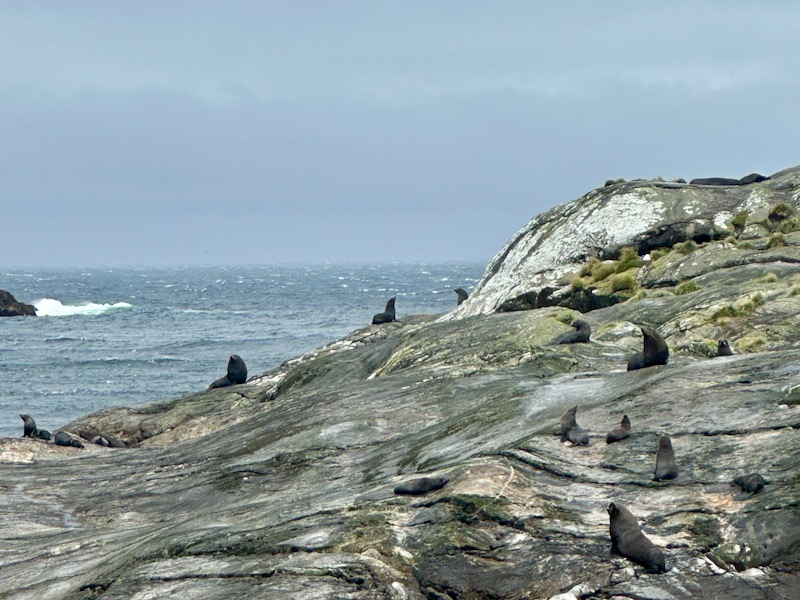
Doubtful Sound isn’t just about waterfalls and moody landscapes — it’s also one of the best places in New Zealand to spot rare and native wildlife. From playful pods of bottlenose dolphins to the elusive Fiordland crested penguin, each season brings its own set of highlights. Cruises often include commentary on local species, so keep your camera ready and your eyes peeled.
Bottlenose Dolphins — Year-Round
Fiordland is home to a unique population of bottlenose dolphins, which are larger and more resilient than those found elsewhere in New Zealand. They’re seen year-round in Doubtful Sound, often swimming alongside cruise boats or playing in the wake.
- Most active in spring and summer when water temperatures rise
- Can be seen on both day and overnight cruises
- Often travel in small pods
Fiordland Crested Penguins — Spring (Sept–Nov)
One of the rarest penguin species in the world, the Fiordland crested penguin (tawaki) nests in the dense coastal rainforest near Doubtful Sound. Sightings are best in spring, during their breeding season.
- Usually spotted on rocks or near the shore
- Spring (especially October–November) is the best window
- Shy and elusive — binoculars are helpful!
New Zealand Fur Seals — Year-Round
You’ll often spot fur seals basking on rocky outcrops or diving in the water. These guys are around in all seasons and are usually easy to spot during any cruise.
- Look for them lounging on rocks near the fiord’s entrance
- Most active on sunny days
- Often seen during day cruises and overnight trips
Native Birdlife — Best in Spring & Summer
The surrounding rainforest is alive with native New Zealand birds, including tūī, kea, and kererū. Warmer seasons bring more activity, so spring and summer are best for birdwatching.
- Tūī: Recognizable by their melodic calls and iridescent feathers
- Kea: The world’s only alpine parrot — cheeky and curious
- Other birds: Bellbirds, fantails, and the occasional morepork (ruru)
Pro Tip: Early morning is best for bird sounds — if you’re on an overnight cruise, try stepping out at dawn.
Crowds & Pricing by Season
When you visit Doubtful Sound doesn’t just affect the weather — it also impacts how many people you’ll be sharing the experience with and how much you’ll pay for it. While this remote fiord is never exactly “crowded” compared to Milford Sound, there are noticeable differences between peak and off-peak seasons, especially when it comes to cruise availability and pricing.
Here’s how the seasons stack up:
| Season | Crowd Levels | Cruise Pricing |
|---|---|---|
| Summer | High – busiest season | Highest – book early |
| Autumn | Balanced – fewer crowds | Moderate |
| Winter | Lowest – very quiet | Discounted/off-season rates |
| Spring | Light to moderate | Moderate – rising in Nov |
Summer (Dec–Feb)
This is peak season in Fiordland, especially around the holidays and into January. Day cruises and especially overnight options book out fast, and you’ll notice more tour buses and full boats.
- Expect higher prices, limited availability on popular dates
- Ideal for those seeking the best weather and longest days
- Book 2–3 months in advance for overnight cruises
Autumn (Mar–May)
As the busy season winds down, autumn offers a sweet spot: fewer travelers, better availability, and more flexibility. Prices may start to dip slightly, especially in late autumn.
- A great option for spontaneous travelers
- Ideal if you prefer quiet experiences over warm weather
- Moderate pricing and good cruise availability
Winter (Jun–Aug)
Winter is the least crowded and most affordable time to visit. Cruise boats often feel semi-private, and deals are easier to find. Some overnight cruises pause during this time, though day cruises continue to operate.
- Best season for budget travelers
- Cold and wet, but extremely peaceful
- Limited daylight, but dramatic scenery
Spring (Sep–Nov)
Spring offers that “just right” balance: active wildlife, fewer crowds than summer, and fair prices. It’s a particularly good time to find availability on overnight cruises before the summer rush hits.
- Mid- to late spring sees rising demand (especially in Nov)
- Waterfalls and wildlife are in full swing
- Moderate pricing, rising closer to summer
Final Thoughts — What’s the Best Time for You?
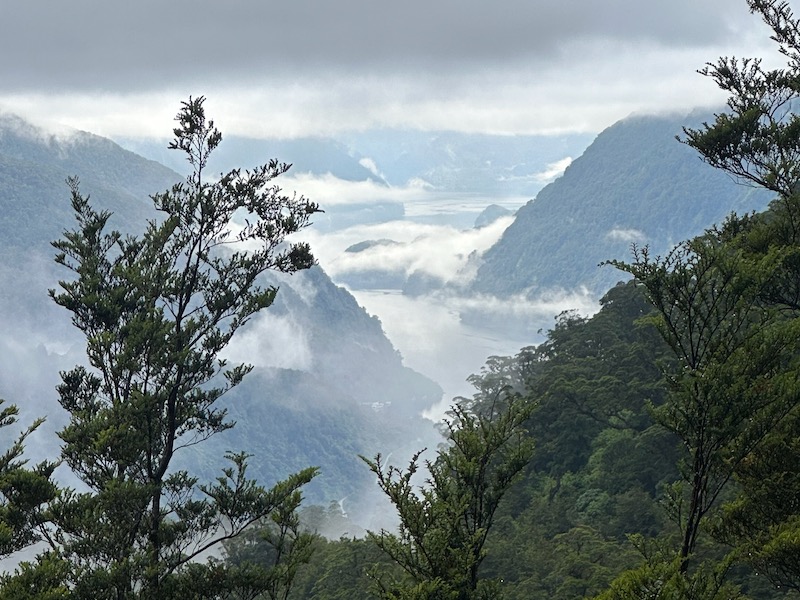
The truth is, there’s no single “best” time to visit Doubtful Sound — it all depends on what kind of experience you’re after. For me, November was perfect. The waterfalls were absolutely wild thanks to the rain, the crowds were minimal, and the whole place had this moody, magical atmosphere I’ll never forget.
Here’s a quick recap to help you decide:
- Want to see wildlife? Go in spring
- Prefer clear skies and long days? Choose summer
- Crave solitude and atmosphere? Winter is your window
- Love photography and waterfalls? Don’t skip autumn or spring
No matter when you go, you’ll be stepping into one of the most untouched corners of New Zealand — a place where silence, scale, and natural beauty take over.
Need more info? Find the rest of my Doubtful Sound travel guides!
FAQs About Visiting Doubtful Sound by Season
These are some of the most common questions travelers ask when planning a visit to Doubtful Sound. If you’re still on the fence about the best time to go, these quick answers should help clear things up.
Can you visit Doubtful Sound in winter?
Yes, you can! Day cruises operate year-round, including in winter. The fiord is especially atmospheric in the colder months — think moody mist, snow-capped peaks, and very few crowds. Just keep in mind that some overnight cruises may pause during winter, so check availability before booking.
Are Doubtful Sound cruises canceled often due to rain?
No — rain is actually part of the Doubtful Sound experience! Cruises run in most weather conditions, and rain often makes the scenery even more dramatic, with dozens of waterfalls pouring down the cliffs. However, extreme weather (like high winds) could occasionally cause cancellations, so travel insurance is a good idea.
Is summer too crowded in Doubtful Sound?
Summer is the busiest time of year, especially from late December through January. That said, it’s still nothing like the crowds you’ll find at Milford Sound. Just book your cruise early, especially if you’re planning to go overnight or around the holidays.
What’s the best time for photographers?
Autumn and winter are ideal for moody, atmospheric shots — think fog, low light, and dramatic skies. Spring is great for waterfalls and greenery, while summer offers clearer conditions and longer golden hours.
Can I see dolphins all year in Doubtful Sound?
Yes! Bottlenose dolphins are present year-round in Doubtful Sound. They’re often seen swimming near cruise boats in small pods, especially in the warmer months when they tend to be more active.

